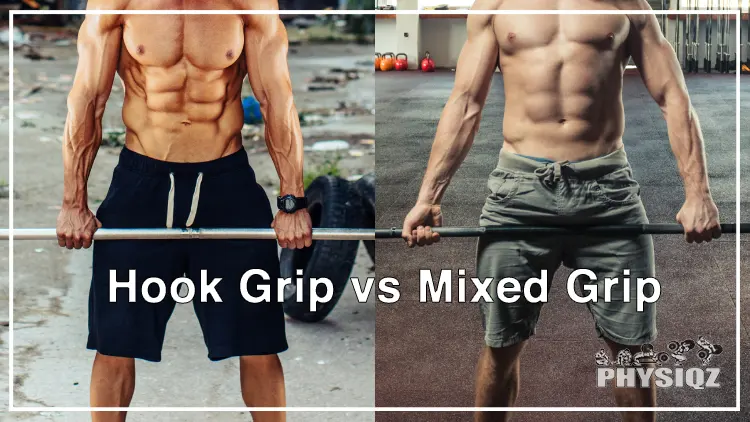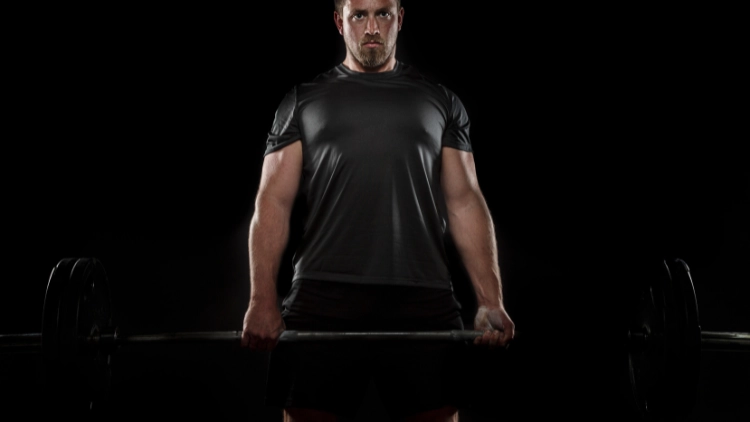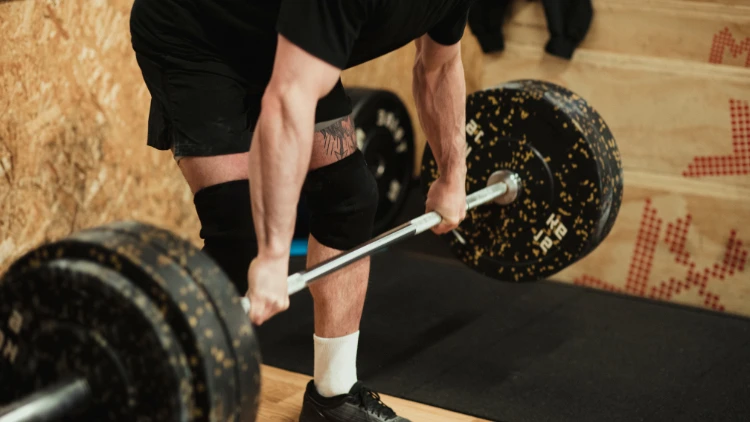
The hook grip vs mixed grip is a subject of extensive debate in gyms worldwide, with athletes in each lifting sport taking sides.1
Truth be told, there are pros and cons to both but the real reason you should switch to hook grip ASAP is that mixed grip will lead to imbalances and as heavier weight is pulled, mixed grip encourages supinated (underhand) hand to open as the hand drags up the leg.
Of course, there’s a use case for each but once you understand each more thoroughly you can make the decision for yourself and even explain why you made the switch to your fellow gym-bros.
The Different Deadlift Grips: Hook Grip & Mixed Grip
To maximize their deadlift workout program, lifters must understand the distinctions between the hook and mixed grip. The deadlift, in itself, is a grip-intensive exercise and when a person does not use the proper grip, it can lead to the repetitions slowing down and unnecessary stress on the hips and back.
Mixed Grip: The mixed grip is the most common grip used in deadlifting. When performing the mixed grip, one arm is supinated (underhand with palm facing upwards), and the other is pronated (overhand with the palm facing downwards.) Thumbs are also over the fingers as if making a fist.
Hook Grip: The hook grip is considered to be a friction grip where the bar compresses the thumb between the fingers and itself. Also, with the hook grip, both arms are pronated, as with the double overhand grip. If performed correctly, the thumbnail will come to the middle finger instead of using “too much thumb,” which can be painful and less effective when lifting a heavier weight.
Advantages & Disadvantages of Hook Grip vs Mixed Grip
As with anything, there are pros and cons to in the hook vs mixed grip debate and the reason for this largely depends on what the athlete’s goals are.
They might lean towards bodybuilding or simply focus on aesthetics. Perhaps they have a powerlifting meet approaching, requiring them to lift heavy. Alternatively, prioritizing safety, they aim to prevent injuries.
Mixed Grip Deadlifts
While it should not be considered a primary method of performing deadlifts, the mixed grip does offer some critical benefits for those who engage in competitive lifting. On the flip side, however, a few cons need to be acknowledged.
Advantages of Mixed Grip:
Every barbell is going to roll a little bit when performing the deadlift. With this grip, the roll is minimized, allowing greater control of the bar and weight. Aside from the roll, when lifting heavier weights, comfort is imperative to ensure that the athlete can lift as much as possible.
Unlike the hook grip, the mixed grip does not require the thumb to be between the bar and fingers. Instead, it is over the fingers as they would be in a proper fist. This is significantly more comfortable than the alternative.

Source: steele2123 via Canva.com2
With comfort still in mind, this grip has another benefit to be noted, allowing for more repetitions and volume. As opposed to other methods of deadlifting, once fatigue starts to kick in, switching to this method can boost the powerlifter’s repetitions by alleviating fatigue in the hands and forearms, allowing them to engage in the workout longer.
Powerlifting Note: While switching to a mixed grip can help to increase the number of repetitions once fatigue starts to kick in, it’s only a temporary boost, however, and should not be relied upon primarily for strength and development.
Another benefit of the mixed grip is that it provides a mechanical advantage over the hook grip deadlift in that it allows for one to more efficiently lift heavier weight with the additional boost in grip strength being provided. This is because of alternate positioning of the hands with one being pronated and the other being supinated. With the weight being gripped with hands facing opposite directions, it provides its user with the necessary grip strength to move heavier weight.
Disadvantages of Mixed Grip:
Keeping safety in mind, the first con to address is that in rare cases, this grip can lead to tears in the biceps. The arm that is going to be affected is also most likely that person’s dominant arm as that is the one that is usually supinated or with the palm facing outwards in a mixed grip. This occurs when the lift is extremely heavy, and the arm begins to bend in a “bicep curl-like motion” during the lift. Too much stress and the bicep will tear and recoil into a little ball which requires surgical intervention.
Safety Note! When using this grip and lifting heavy weight, DO NOT BEND THE ARMS! The chance of an athlete tearing the bicep increases when doing this. Get in the habit of keeping your arms straight during the lift.
Another con of the mixed grip is that it can lead to asymmetrical development or imbalances. That is because one of the hands is being supinated while the other is pronated. While an imbalance can be prevented by switching which hand is supinated, that is often overlooked. This leads to one side of the body being bigger and stronger than the other. If appearance matters to the athlete, this is a reason to avoid this grip.
A final con of this grip is that if it is not done correctly, it can lead to an athlete developing a rounded back. The rounded back applies to the upper and lower back. A rounded back can lead to back pain as well.
There are individuals who believe it is acceptable to lift with a rounded back in order to maximize the weight deadlift, but that only applies to those who are competing in deadlifts and have trained to prevent back injuries with a rounded back. The rounded back occurs when the body compensates to shorten the barbell’s range of motion (when it is heavy.) This results in the bar being pulled in closer decreased hip flexion angle, and the erector spinae working more as the primary power source as opposed to a stabilizer. If the mixed grip is needed, this is how it needs to be performed.
When performing the deadlift, the goal is to ensure the back is in a straight, neutral position. The mixed grip does not naturally promote that positioning as a hooked grip would, so this is a common issue among powerlifters using this grip.
Hook Grip Deadlifts
First and foremost, one of the main advantages of the hook grip vs the mixed grip is that it is one of the safer of the two lifts. With the mixed grip, one of the arms of the lifter is supinated or with the palms facing inwards. In other words, this puts tension on the bicep tendon.
Too much tension can easily lead to a tear in the biceps, meaning time out of the gym and a long recovery process.
A torn bicep is an excruciatingly painful injury and not one any person engaging in strength training wants to experience. That is why safety is the essential benefit that the hook grip offers.
Advantages of Hook Grip:
Another benefit of the hook grip is that it offers more symmetry (balance) in pulls. This is important for several reasons:
- Muscular Development: As with the overhand grip, traps, lats, and lower back are equally loaded, preventing different sides of the body from working harder and developing more than one side.
- Strength Development: Just like with muscular development, this grip allows both sides of the body to be equally engaged in the lift, allowing both to build strength at the same rate.
- Less overall stress on the body: With this grip, stress is more equally distributed, preventing unnecessary stress on the shoulders, hips, and lower back.

Source: SolStock via Canva.com3
As mentioned earlier, deadlifting is still a grip exercise, and one of the most frustrating things that can happen to a powerlifter during a set is feeling the bar slipping in their grasp. One of the key benefits of the hook grip is that it is highly secure. The bar can be held longer and more firmly due to the extra space between the fingers and the bar.
Disadvantages of Hook Grip:
While all of this is great and ideal for most athletes looking to be safe and maintain a symmetrical strength and appearance, one drawback of using a hook grip over a mixed grip, however, is comfort.
This method of gripping the bar is not one that a powerlifter would want to use in competition or heavy sets. That is due to the position of the thumb. It is incredibly uncomfortable and painful, so unless someone has been training with the grip for a while, it will take some time to get used to it.
The bar resting on the thumb and heavier weight doesn’t feel good and can be unbearable to the average person. The hook grip is not a grip for a powerlifter looking to throw up as much weight as possible for a meet or 1RM but many still train with a hook grip because of the points above.
Powerlifting Note: One potential drawback for a powerlifter could be the size and condition of their hands. If an individual has small hands or previous injuries, it could be virtually impossible to grab the bar like this. An alternative measure to get similar benefits would be to use deadlift straps.
Hooked Grip or Mixed Grip: What’s the Best Grip for Deadlifts?
There is no comparison when determining whether a hook grip or mixed grip is best for performing deadlifts. The hooked grip will be the best option for any gym-goer who wants to achieve the best results in their deadlifting routine.
The risk of tearing a bicep is nonexistent, muscular symmetry is maintained, and the lifter’s back is not at as much risk. The only downside is that the grip prevents a person from lifting as much weight. However, if a person is not competing in powerlifting, that’s not a drawback.
Hook Grip & Mixed Grip: What’s the Use Case for Each?
Determining when to use the hook grip and mixed grip doesn’t have to be complicated. Primary factors are determined by:
- The personal goal of the athlete
- Whether straps or chalk are allowed where the athlete is deadlifting
If an individual is deadlifting to improve their appearance and reduce their risk of injury, the hook grip will be the obvious choice. They won’t be preparing for or actively competing in a powerlifting event, so there is no need or purpose for this athlete to utilize the mixed grip as it works against their goals. It’s also an excellent grip to go to when some federations don’t allow for the use of straps or chalk since it is an exceptional grip.
Powerlifting Fact! The hook grip is the approved grip of Olympic powerlifters due to its strength and straps not being allowed in competition.
The mixed grip can be used when an individual is trying to pump out those last reps within their sets, but this grip belongs to the competitive world where the athlete can pick up the heaviest weight and put it down. Other than that, it doesn’t have many suitable applications for use.
How To Use Hook Grip When Deadlifting
The hook grip should be the natural progression from a double overhand grip when a person’s strength increases. As the weight increases, the double overhand grip will begin to fail, which is where the hook grip comes in.
It must be appropriately engaged to get the most out of it and prevent injury.
- First, when engaging the bar, keep arms shoulder-width apart.
- Place both open palms on the bar at a shoulder-width distance.
- Tuck thumbs in underneath the bar while keeping the pointer finger – pinky fingers open as if counting to four.
- Close the rest of the hand
- Now the thumbs should be underneath the index and middle fingers (not passing the thumbnail); this creates “the hook” for a more secure and robust grip.
There is no comparison when it comes to the pros and cons. The increased safety even loads distribution to prevent asymmetry, and reduced stress on the back; hook grip addresses it all. In the debate of hook grip vs mixed grip, hook grip is the winner.
References
1eclipse_images. “Deadlift.” Canva. Accessed 11 April 2023. <https://www.canva.com/photos/MAEJL_rdb_Q-deadlift/>
2steele2123. “Deadlift.” Canva. Accessed 11 April 2023. <https://www.canva.com/photos/MAEJGuuZ74c-deadlift/>
3SolStock. “Man Performing a Deadlift.” Canva. Accessed 11 April 2023. <https://www.canva.com/photos/MAEI2PJF5Hs-man-performing-a-deadlift/>